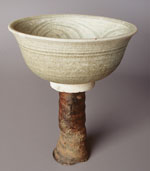| Discovering Asia's
ceramic development |
Clay & slip, spur
discs & tubular supports

 The
picture on the left shows how early Sukhothai and Sisatchanalai underglaze wares
from the Turiang shipwreck would have been stacked in the kiln, separated by
spur discs and on a single tubular support. At this time, both places used the
same stacking method.
The
picture on the left shows how early Sukhothai and Sisatchanalai underglaze wares
from the Turiang shipwreck would have been stacked in the kiln, separated by
spur discs and on a single tubular support. At this time, both places used the
same stacking method.
The picture on the right shows how Sisatchanalai eventually stacked celadon,
on individual tubular supports. The Sukhothai kilns continued to use spur discs
throughout their production period, despite the scars caused.
 The
third picture shows the different clays used in Sukhothai and Sisatchanalai
over time. (Click the image to see close-up detail.) The middle sample with
its white quartz particles was used at Sukhothai throughout its production period.
The
third picture shows the different clays used in Sukhothai and Sisatchanalai
over time. (Click the image to see close-up detail.) The middle sample with
its white quartz particles was used at Sukhothai throughout its production period.
The lower sample shows the secondary clay used in early Sisatchanalai ware.
As with the gritty Sukhothai clay, this was rough, and needed to be covered
with a layer of 'slip' (smoother liquid clay) before painting. The added layer
can be seen in the cuts below the glaze.
The top sample shows the finer grey clay used for later Sisatchanalai celadon.
Decoration could be incised directly in this semi-hard clay. (Incised decorations
are fine lines carved in the clay. Deeper glaze in the cuts appears darker green,
adding soft contrast to the motif.)

 The
picture on the left shows how early Sukhothai and Sisatchanalai underglaze wares
from the Turiang shipwreck would have been stacked in the kiln, separated by
spur discs and on a single tubular support. At this time, both places used the
same stacking method.
The
picture on the left shows how early Sukhothai and Sisatchanalai underglaze wares
from the Turiang shipwreck would have been stacked in the kiln, separated by
spur discs and on a single tubular support. At this time, both places used the
same stacking method.